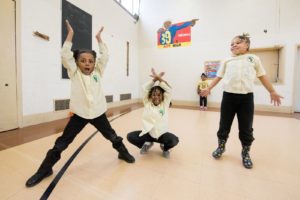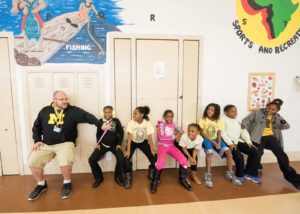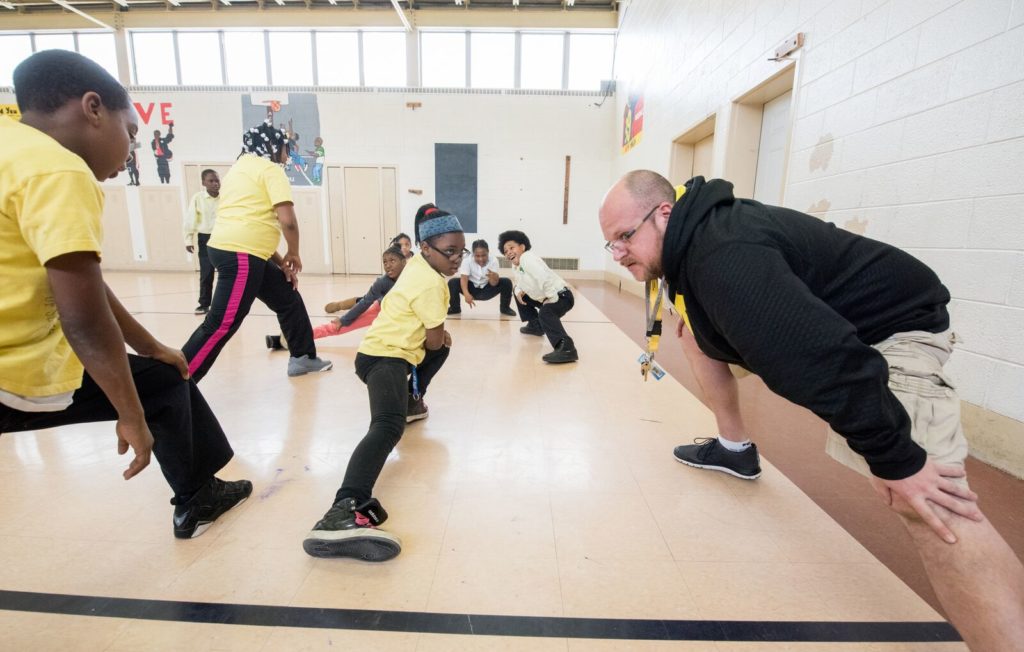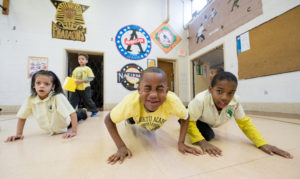The kids can hardly contain their excitement.
It’s PE (physical education) time.
They’re waiting for the “big” signal.

“Baba” Eric Hoffman the PE teacher calls out the words Army, Air Force, or Navy. The kids have to run to each line correctly. Go to the wrong line and they’re out. It’s a warm-up game designed to get the students moving.
“I actually like gym because it helps you exercise your mind and your body,” says third-grader Arianna Cantie. “I like gym because it’s different. When we do Army, Navy and Air Force, we start playing and having fun.”
Fourth-grader Kierra Cummings says Army, Air Force, Navy is her favorite game.
“I think it’s fun because we do a lot of athletic stuff you might not get to do at home like exercising (and) using the jump rope,” Kierra says. “It lets you stretch out your legs.”
“I think the PEprogram is good because I like to play basketball,” says fourth-grader Bryant Simmons. “He (Hoffman) has us run and we do toe touches, arm stretches, leg stretches. He gives us free time at the end. Some people like to play with the scooters.”
Hoffman used to work on the line at the Ford Sheldon Rd. plant in Plymouth building air conditioners. He took the buyout in 2006 and went back to school at Eastern Michigan University. He first taught physical education (PE) at Hamilton Academy and Henry Ford Academy: School for Creative Studies. Today, you can find him in the gym at Timbuktu Academy of Science and Technology.

In his first year as the school’s PE teacher, he’s determined to get the students up and running with the Building Healthy Communities (BHC) program’s Exemplary Physical Education Curriculum (EPEC).
BHC, originally created by Blue Cross Blue Shield of Michigan in 2009, is an evidence-based, comprehensive, school-wide initiative supported by multiple statewide organizations, including the Michigan Department of Health and Human Services, the Michigan Fitness Foundation, University of Michigan, United Dairy Industry of Michigan and Wayne State University Center for School Health, working together to teach kids healthy habits, address childhood obesity and transform the school environment. The program has reached more than 180,000 students in more than 390 Michigan schools.
“It’s a good curriculum,” Hoffman says. “Instead of them chasing each other around, it’s more organized.”
Still, it’s a challenge. There’s little time for PE classes. The students have recess for a half hour and receive only 60 minutes of PE weekly.

“I see each class once a week,” Hoffman says. “My time is very limited, so it’s been difficult to work with them on that. I’m going to suggest next year that the kids can have PE at least twice a week.”
While Hoffman would like more time allotted for his class, it’s a challenge.
According to the National Education Association, the No Child Left Behind Act requires teachers to spend more time preparing their students for tests on English/language arts and math. How the children do on those tests determines how dollars are allocated for that school. That has nudged aside PE and other programs.
“It’s tough,” Hoffman says. “The day is short. You get your money based on test scores. PE is really pushed to the side. People really don’t see the importance of it. The more active you are, the better you do in the classroom.”
For schools that may not have the advantage of BHC’s program, there are still some things teachers, administrators and parents can do to spur physical activities in their schools. Hoffman suggests talking with the parents and creating more afterschool programs.
Another key, he says, might be integrating a team aspect into the play, as opposed to simply having a free-for-all.
“That’s part of it,” Hoffman says. “If it’s not organized, the kids tend to go towards certain sports. The boys want to go towards basketball or football. You don’t see them trying anything different like playing soccer.”

Either way, lack of activity contributes to obesity. The BHC program can help those children.
“You don’t want to single them out, just encourage them,” Hoffman says. “Have them be active with everyone else. Building Healthy Communities teaches them about foods and what to eat and about a balanced meal.”

In the meantime, EPEC helps Hoffman build a weekly structure for the students.
“It gave me a good perspective on how to quickly teach them with the short amount of time I have,” he says.
Now, in his third month of BHC, Hoffman is slowly seeing the results, but there’s still plenty left to teach.
“The kids are getting used to the routine,” Hoffman says. “So, I’ve only seen everybody maybe 10 or 12 times, getting them used to the routines and consistent with that. At the schools I worked at in the past it was on me to make sure what the kids were doing every day. Hopefully, with the next semester I can implement more of the EPEC curriculum.”
Photos by Paul Engstrom
RELATED POSTS
Building Healthy Communities aims to curb childhood obesity by keeping kids active, eating right
Students at Timbuktu Academy learn how to build a healthy community
Try it Tuesdays: How schools are helping our kids develop healthier habits
Power Off: Why kids need a break from technology
Moving Forward: A PE teacher’s perspective on how BHC is making a difference
UPDATE:
If you are a K – 5 school, it’s time to apply to participate in the 2017 – 2018 Building Healthy Communities program, a free program offered to qualified schools (March 29 registration deadline).
Additional K – 12 school programs will be announced soon.
To sign-up or learn more visit: bcbsm.com/buildhealth



Pingback: Students at Timbuktu Academy learn how to build a healthy community – The HUB Flint